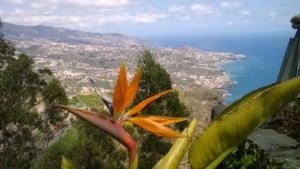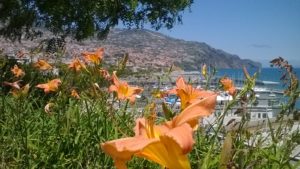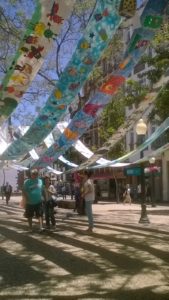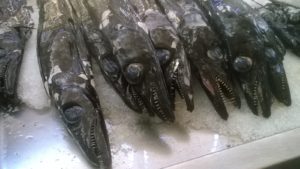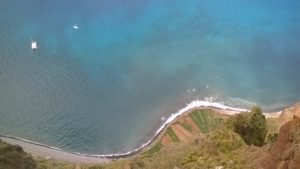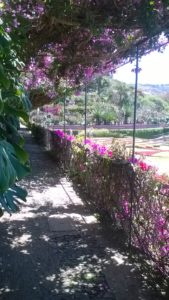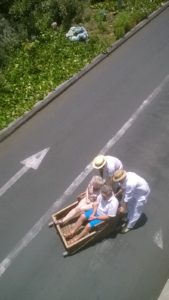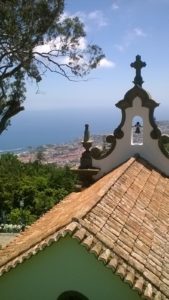Probably the first things people think about when they hear the word Madeira is the lovely golden-yellow, close textured cake or the rich, satisfyingly smooth taste of Madeira wine.
There is much more to the islands than these two items. Madeira wine does have its own story however.
At sea on long journeys, wine cargo was often spoiled and to prevent this, it was fortified with brandy. The casks underwent huge temperature changes on the long voyages to the East Indies and The New World. On one round-trip journey when some barrels of wine were returned, it was noticed that the wine had gained a mellow and refined flavour from these fluctuations.
Experimentation showed that repeated heating and cooling improved the flavours and so the Madeira Wine process was born. It ranges in style from dry to sweet, the richest and sweetest being referred to as Malmsey wine, which is made from locally grown Malvasia grape varieties.
I am a great fan of this wine, but not as much as the Duke of Clarence, who, according to Shakespeare, when sentenced to death, opted to be drowned in a butt of Malmsey wine. Glug, glug ,glug!
The cake we know as Madeira cake does not contain the wine, nor does it originate in Madeira. It was served in 18th and 19th century England alongside glasses of the wine and gained it’s name by association. One of the earliest recipes was published in England in 1845.
To confuse matters, Madeira DOES produce its own Madeira cake, Bolo de Mel, but this is a dense, dark and spicy, molasses and honey flavoured cake, very different from our own confection.
Madeira itself is actually an archipelago of four islands, with Madeira being by far the largest at 35 miles by 14 miles, and having 90 miles of coastline. The surrounding, crystal clear sea varies from 18 to 26C, depending on the time of year. No wonder Madeira is called the Pearl of the Atlantic.
Geographically it is 250 miles North of Tenerife and 280 miles from the coast of Africa. It is the visible part of a 20,000 foot volcano which rises from the sea-floor, though there is no need to worry, as the volcano hasn’t been active for more than 6,500 years.
The central mountain ridge rises to the peak of Pico Ruivo at 6109 feet, though the interior of the island is largely inaccessible due to steep sided and forested mountains.
The islands benefit from a year-round warm, sub-tropical climate and has an average daily temperature of 67.3F (19.6C), making it a very popular tourist destination. Indeed, the one million or so tourists the island attracts each year far out-weigh the resident population of almost 270,000.
If you are searching for golden sandy beaches however, you will be disappointed by the volcanic, grainy black sand here. Most of the beaches are in fact pebbly but at Calheta and Machico in the South and North-East of the island respectively, you will find beaches with specially imported golden sand. To make up for it, the sea is absolutely diamond clear and warm. Perfect for swimming and snorkelling. The variety of colourful fish species to be seen is amazing.
By contrast, the nearby island of Porto Santo has an unbroken 9km stretch of beautiful, natural golden sand. This island can easily be reached by a two hour ferry trip from Funchal on day trips.
Archaeological excavations have proved that the island was known to the Vikings, but the first permanent settlements were made by the Portuguese in the 1420’s.
These settlers created agricultural areas, the most important of which were sugarcane plantations. An enormous and wealthy sugar trade industry sprang up which supported the islanders for centuries.
From the 1640’s to the 1940’s, water channels called Levadas were cut through the mountainsides to irrigate the drier Southern regions of the island. There are some 1350 miles of these water channels still in use today, many of them having footpaths alongside them. Some can be dangerous to walk, having vertiginous drops, but one of the easier ones at 7.1 miles is the Levada do Canical , sometimes known as the MImosa Levada due to the preponderance of these beautiful trees alongside it.
Simply breath-taking and one that HAS to be done.
During the Napoleonic Wars, Britain briefly occupied the island, but this only lasted from 1807 to 1814 before it was handed back to Portugal. The island was granted political autonomy in 1976 and the islanders have never looked back.
The modern coast road from the airport is a twisty, switchback ride of tunnels and viaducts which bridge the volcanic valleys. It is almost a big kid’s large scale Scalextric set. As Funchal heaves into view around a bend you see houses stretching up into the steep hillsides, Rio-style.
As you tour the island it seems that every inch of garden and hillside has been terraced and planted with fruit, grape vines and vegetables or tightly packed banana trees.
Most visitors will gravitate to the capital, Funchal. The city is named after Fennel (Funcho) which was found growing in abundance by early settlers.
It is on the Southern, more sunny coast, surrounded on three sides by mountains.
This is one of the safest, cleanest and virtually crime free cities in the whole of Europe. It is safe to walk around at any time of day or night.
The city has a deep water harbour which caters for the many cruise ships which arrive and depart regularly. Tourists arrive for the picturesque old cobbled streets, with numerous street cafes and restaurants from which to dine al fresco and ‘people-watch’. One of the best places for this is at any of the street cafes adjacent to the Cathedral. The old town vies with discreetly placed modern shopping complexes whilst at night, the city is a picture, with lights twinkling from the mountain-side streets.
A glorious day out can be had by taking the Monte Cable Car from the seafront of the old town district of Funchal on a scenic ride to the village of Monte. At the top, there a choice is to be made. Either explore the Monte Palace Tropical Gardens or take a ten minute walk and then an onward cable car to the islands’ premier attraction, the Botanical Gardens.
I thought the latter needed a bit of t.l.c. in places and of the two, would recommend the former, they reminded me of the Lost Gardens of Heligan in Cornwall, only more exotic.
Be aware that at both of these gardens, some of the paths are rocky or earthen, uneven and quite steep in places. Stout shoes as well as legs are required.
Of the three cafes here, I think the best takes a bit more effort to get to. Take the steep path further up the hill from the cable car terminus at Monte towards a small, white church. Here you will find the Panoramic Gardens of the Quinta do Monte Hotel, and a little gem of an outdoor café with magnificent views over Funchal. Cheaper too.
On the return journey to Funchal, not to be missed is an exhilarating downhill street ride from Monte in a ‘Carro do Monte’, a two seat wicker toboggan on wooden runners, guided by the traditionally dressed ‘carreiros’.
This is a ten minute, two kilometre, helter-skelter downhill ride through narrow streets, reaching speeds up to 48 kph., the only braking power being the rubber soled boots of the skilled navigators. Phew!
A ride into the mountains on any one of Madeira’s seven cable car rides are also options to consider. The views from the top are stunning.
Highly recommended are the Yellow Bus Tours. Buy the three-in-one trip at only 15 euro’s.This ticket lasts 48hrs and is unlimited hop-on, hop-off.
One trip takes in Funchal town and ventures into the high hills above the town.
The second goes along the coast to Camara de Lobo, a pretty fishing village. At the bus stop, try the Cafe Forma d’Acucar. It has an outdoor terrace with the best views of the harbour, whilst the shop below has free wine and cake tasting.
For the third trip, swap to the waiting mini-bus up into the hills to the Cabo Girao, via tortuously steep mountain roads.
At the top you can walk out on a glass walkway (free) over the highest sea-cliff in Europe (and the second highest in the world), to see the beach 1902 feet below. Jelly Legs!! The views down the coast are so dramatic.
Full day Island tours of the East, West and Levada Walks can also be easily booked.
The Laurisilva (Laurel) Forest is a UNESCO World Heritage Site which contains the largest area of primary laurel forest in the World. The evergreen trees dominate the steep sided valleys of the central mountains and to the North. It lies within the Madeira Natural Park and is largely undisturbed. It is almost primeval in appearance with abundant wildlife, butterflies and birds. Look out for the huge, orange and black Monarch butterflies.
Garajau Marine National Park protects the marvellous variety of undersea wildlife, whilst Whale and dolphin watching trips prove to be an unforgettable day out by boat.
Big Game fishing trips can also be arranged.
The islanders are keen on Festivals and Parades, with almost monthly events following on from each other. In June it is the turn of the Atlantic Festival which includes an International Fireworks competition each Saturday evening in Funchal. The harbour waters light up in brilliant colours and is truly impressive. The display on New Year’s Eve is officially (Guinness Book of Records) the biggest in the World. Think London or Sydney has the title- NO!
From 30th August to 6th September, to coincide with the grape harvest, the Madeira Wine festival is held. Parades, exhibitions and of course, the all important wine tasting feature heavily. Take a tour of one of the Madeira Wine producers for a day to remember – if you can!
The tour of Blandy’s factory in Funchal is well worth a visit to see and taste the wines for yourself. Purchases are also cheaper here and can be collected after security at the airport on the way home.
The Island’s cuisine is one to savour. The ubiquitous Espada is a Black Scabbardfish which looks terrifying, but is simply delicious. It is a predator fish, having large eyes to see in the 1000 metre depths it lives at. It has long jaws with savage looking, razor sharp teeth. These fascinating creatures can be seen at any of the fish markets on the island. The flesh is white and firm. It is often served with hot grilled banana.
I would advise meat eating fans to have the island’s signature dish, Espetada.
Huge chunks of local beef are rubbed with garlic, salt and bay-leaf, then marinated in Madeira Wine, placed on laurel skewers and grilled over smoking wood-chips.
My mouth is watering as I type!
The local beer from Madeira Brewery is Coral. This is a perfect accompaniment to both of the above dishes and is a premium lager, similar to Stella and at 5.1%, not a session beer!
The local hooch is Poncha, a heady mix of orange, lemon, honey and rum. Very powerful at 25% proof, so don’t treat it as a soft drink. It ain’t.
Afternoon tea, taken at Reid’s hotel is a traditional right of passage and an experience that you have to have at least once in your life. This hotel is regarded as one of the best in the world. For those on a budget, however, Petit Four’s Cafe just opposite Reid’s is a good quality, more reasonably priced alternative.
For dining out, any of the street cafes serve up local Portuguese dishes, but the fact you have to pre-book at Restaurante X Tonel, opposite Reid’s Palace, tells it’s own story. Unprepossessing from the outside, it is spotlessly clean, very reasonably priced, and has great staff and food. The accompanying platter of eight vegetables from Madeira island that comes with most dishes is legendary.
So, still think Madeira is all cake and wine?
Think again.
If you want a five star hotel treat whilst visiting Madeira, see www.cliffbay.com.
There is a separate review of this hotel on Silver Travel Advisor (see “Cliff Bay Hotel”:http://www.silvertraveladvisor.com/review?id=165112).
